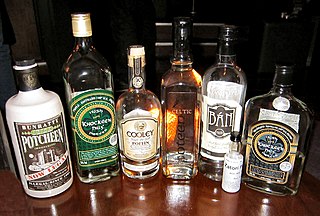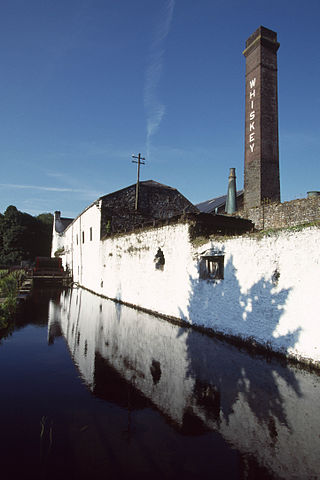Related Research Articles

Irish whiskey is whiskey made on the island of Ireland. The word 'whiskey' comes from the Irish uisce beatha, meaning water of life. Irish whiskey was once the most popular spirit in the world, though a long period of decline from the late 19th century onwards greatly damaged the industry, so much so that although Ireland boasted at least 28 distilleries in the 1890s, by 1966 this number had fallen to just two, and by 1972 the remaining distilleries, Bushmills Distillery and Old Midleton Distillery, were owned by just one company, Irish Distillers.

Poitín, anglicized as poteen or potcheen, is a traditional Irish distilled beverage. Former common names for Poitín were "Irish moonshine" and "mountain dew". It was traditionally distilled in a small pot still and the term is a diminutive of the Irish word pota, meaning "pot". In accordance with the Irish Poteen/Irish Poitín technical file, it can be made only from cereals, grain, whey, sugar beet, molasses and potatoes.

Paddy is a brand of blended Irish whiskey produced by the Sazerac Company. As of 2016, Paddy is the fourth largest-selling Irish whiskey in the World.

Urris is a valley to the west of the parish of Clonmany, in County Donegal, Ireland. It comprises the townlands of Crossconnell, Dunaff, Kinnea, Leenan, Letter, and Urrismenagh. It sits on the eastern side of Loch Swilly and it is bounded to the south-east by the Urris hills, and to the east by Binion hill. To the north, there is Rockstown bay and Tullagh peninsula. There are two entrances to Urris; the Gap of Mamore, and Crossconnell.

Kilbeggan Distillery is an Irish whiskey distillery situated on the River Brosna in Kilbeggan, County Westmeath, Ireland established in 1757 and owned by Suntory Global Spirits, a subsidiary of Suntory Holdings of Osaka, Japan.
Aeneas Coffey (1780–1839) was an Irish inventor and distiller.

Powers is a brand of Irish whiskey produced by the Irish Distillers subsidiary of Pernod Ricard. Historically a single pot still whiskey, the flagship Powers Gold Label brand was the first Irish whiskey ever to be bottled. Powers Gold Label was the best-selling whiskey in Ireland.

The Old Midleton Distillery, also known as the Jameson Experience, Midleton, is an former Irish whiskey distillery that was turned into a museum and visitor centre located in Midleton, County Cork, Ireland. Set over 15 acres, since opening as a visitor's centre in 1992, the old distillery has received approximately 100,000 guests per year, receiving 125,000 in 2015.

Allman's Bandon Distillery was an Irish whiskey distillery which was established in 1826 in Bandon, County Cork, Ireland. The distillery closed in 1929 following financial difficulties. However, agents for the company trading under the name Allman, Dowden & Co., may have continued to sell off the existing stock which had built up in bonded warehouses, in both cask and bottled form, until 1939.

The Isle of Doagh is a small peninsula in the north of Inishowen on the north coast of County Donegal in Ulster, Ireland. It once was an island. Over time, the channel between Doagh and the mainland silted up and it became joined to the mainland. Nevertheless, the area continued to be referred as the Isle of Doagh or Doagh Island. The area comprises five townlands; Ballymacmoriarty, Carrickabraghy, Carrowreagh, Fegart and Lagacurry. Doagh Island is very near the village of Ballyliffin.

The Thomas Street Distillery was an Irish whiskey distillery located in Dublin, Ireland. At its peak, it was Dublin's largest and most productive distillery and with an output of over 2 million gallons per annum, twice that of John Jameson's acclaimed nearby Bow Street distillery.

The Marrowbone Lane Distillery was an Irish whiskey distillery located on Marrowbone Lane, in Dublin, Ireland. One of the "big four" historical Dublin whiskey firms, it was run by William Jameson, a member of the Jameson whiskey dynasty. However, the whiskey now known as Jameson Irish Whiskey was not produced at this distillery, but at the separate enterprise run by John Jameson at the nearby Bow Street Distillery. The distillery closed in 1923 following financial difficulties.

Teeling Distillery is an Irish whiskey distillery established in Dublin in 2015 by the Teeling Whiskey Company and owned by Bacardi Limited.

The Dundalk Distillery was an Irish whiskey distillery that operated in Dundalk, County Louth, Ireland between 1708 and 1926. It is thought to have been one of the old registered distilleries in Ireland. Two of the distillery buildings, the grain store and maltings, still exist and now house the County Museum and Dundalk Library.

Daly's Distillery was an Irish whiskey distillery which operated in Cork City, Ireland from around 1820 to 1869. In 1867, the distillery was purchased by the Cork Distilleries Company (CDC), in an amalgamation of five cork distilleries. Two years later, in 1869, as the smallest CDC distillery, Daly's Distillery ceased operations. In the years that followed its closure, some of the buildings became part of Shaw's Flour Mill, and Murphy's Brewery, with others continuing to be used as warehouses by Cork Distilleries Company for several years.
The Green Distillery was an Irish whiskey distillery which was established in Cork City, Ireland in 1796. In 1867, the distillery was purchased by the Cork Distilleries Company (CDC), in an amalgamation of five Cork distilleries. Production of whiskey at the distillery likely ceased soon afters its acquisition by the CDC. However, the distillery is known to have remained in use a bonded store by the Cork Distilleries Company for several years thereafter. In the mid-twentieth century, the distillery resumed operations as a gin distillery for a period of time, however, it has since been almost completely demolished.

Bishop's Water Distillery was an Irish whiskey distillery which operated in Wexford, Ireland between 1827 and 1914. The distillery was named for a stream which ran along the back of the distillery, the Bishop's Water, said to possess "various occult properties derived from the blessings of the sainted Bishop of Ferns".

Nun's Island Distillery was an Irish whiskey distillery which operated in Galway, Ireland, from at least 1815, and possibly as early as the late 1700s, until circa 1908.
Marlfield Distillery was an Irish whiskey distillery which operated in the village of Marlfield, just outside of Clonmel, Ireland between approximately 1817 and 1856.
Hackett's Distillery was an Irish whiskey distillery which operated in Midleton, County Cork, Ireland between 1824 and circa 1845.
References
- 1 2 3 4 5 6 7 8 9 Townsend, Brian (1997–1999). The Lost Distilleries of Ireland. Glasgow: Neil Wilson Publishing. ISBN 9781897784877.
- 1 2 Parliamentary Papers, Volume 34. Great Britain: HMSO. 1832.
- 1 2 3 4 McGuire, Edward B. (1973). Irish whiskey;: A history of distilling, the spirit trade, and excise controls in Ireland. Dublin: Gill and MacMillan. pp. 357–358. ISBN 0064947017.
- ↑ Nettleton, J.A. (1893). The Manufacture of Spirit: As Conducted at the Various Distilleries of the United Kingdom. London: Marcus Ward & Co.
- ↑ O’Connor, Fionnán. A Glass Apart: Irish Single Pot Still Whiskey. Australia: The Images Publishing Group. ISBN 9781864705492.